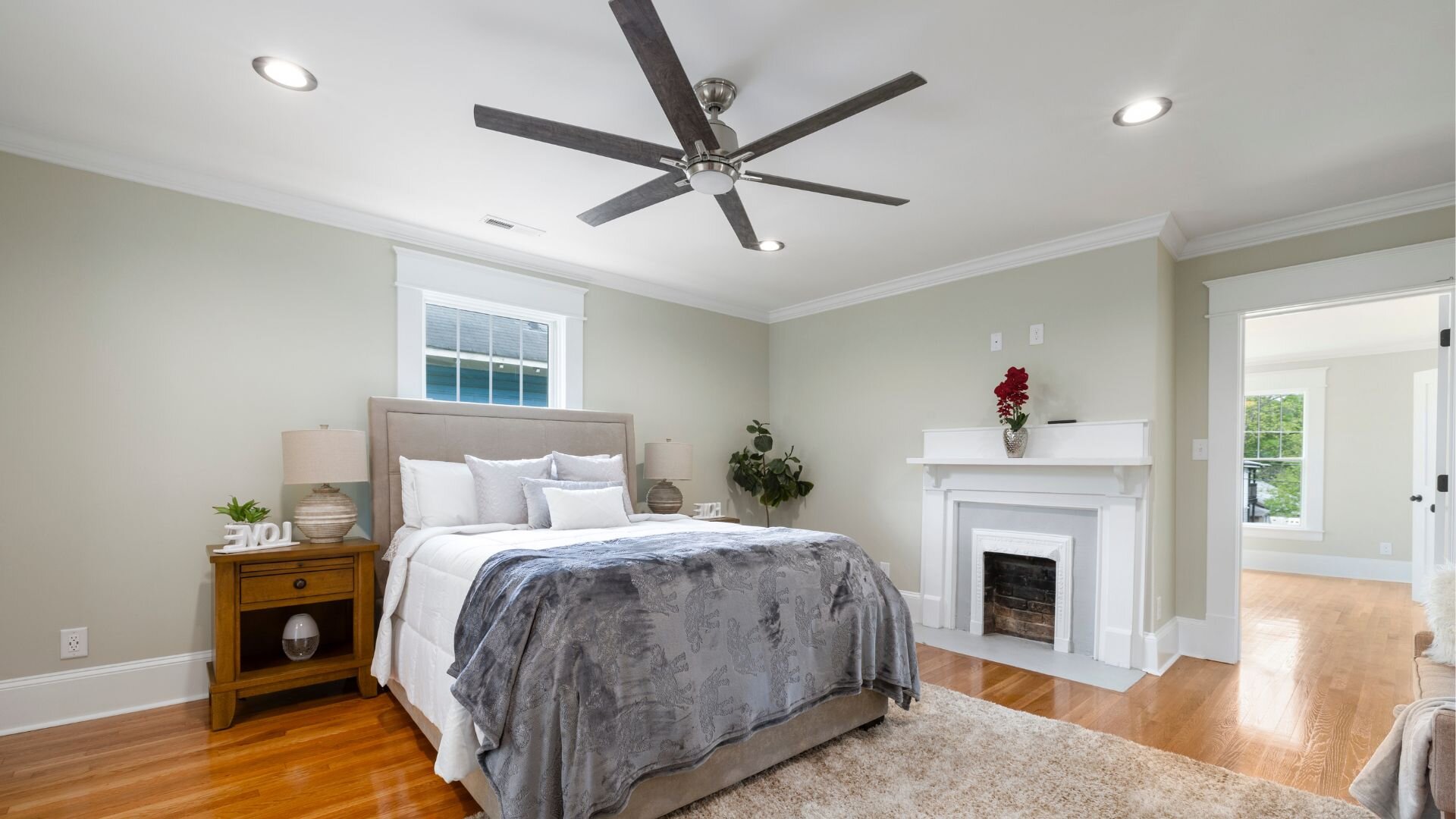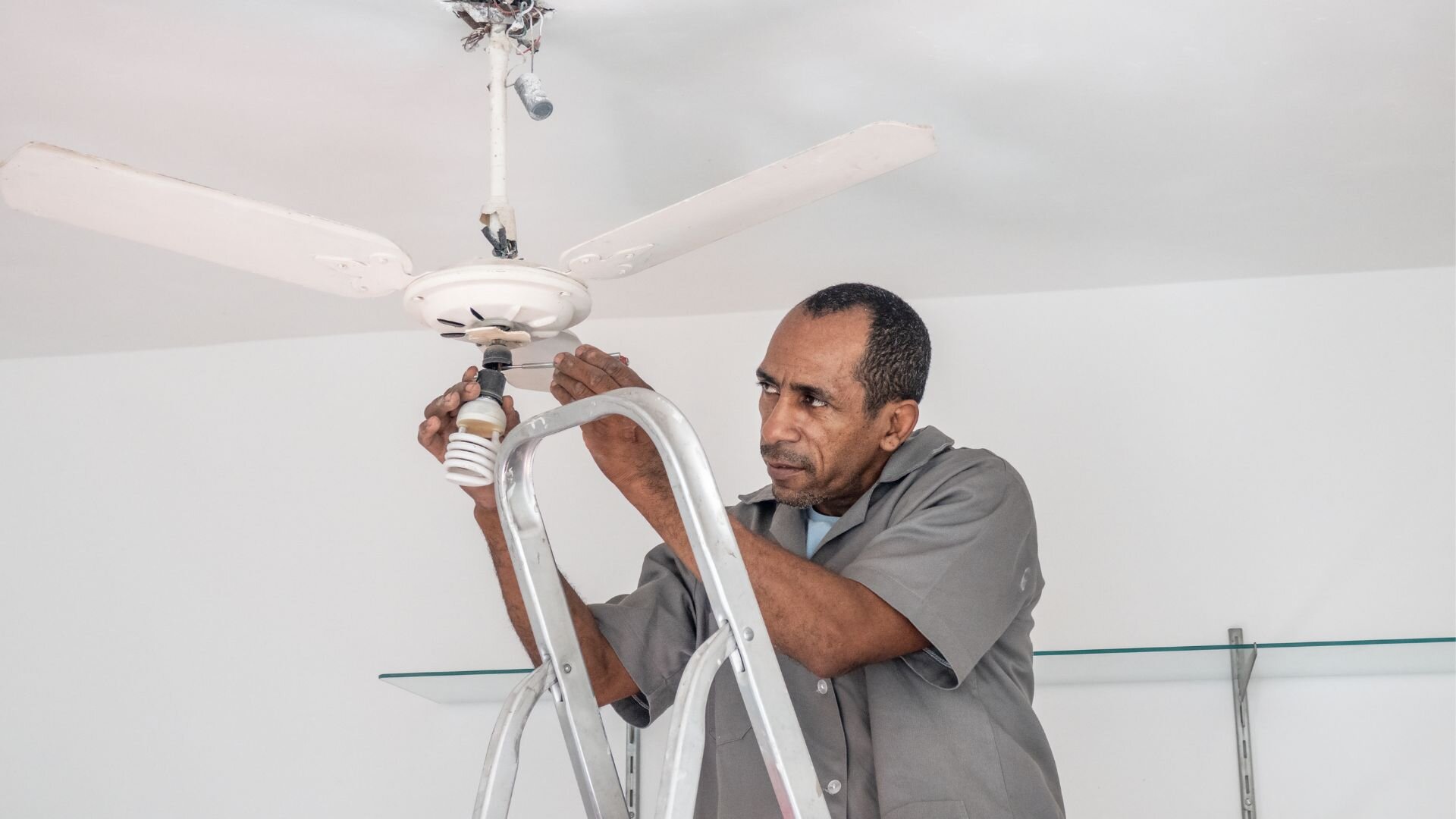A ceiling fan isn’t just about keeping cool; it’s a stylish and practical part of your home. Not only does it circulate air, but it keeps your space comfy by spreading airflow evenly throughout the year. These fans are energy-efficient options compared to air conditioners, helping to cut down on electricity costs while maintaining a pleasant indoor climate.
The right ceiling fan can complement your room’s design and add a stylish touch that blends with your decor. But the wrong fan can disrupt the harmony of your space, either by being too big, too small, or out of style.
This guide will help you choose a ceiling fan that meets your needs and your room. Learn more about residential wiring guide. It will also cover size, style, and functionality.
Measuring Your Room
When picking a ceiling fan, size matters. If a fan is too large, it might overpower a small room; too small, and it won’t do the job right in a bigger space. It’s crucial to match the blade span with your room’s dimensions to guarantee comfort and efficiency.
To measure the right size, measure the length and width of the room in meters and calculate the square metreage (length x width). This will help you choose the right fan.
The blade span is key to airflow, so aligning it with room size is important. Larger spans suit big areas, while smaller rooms fare better with more compact fans.
Recommended Blade Span by Room Size:
- Up to 10m²: 75-105cm
- 10-20m²: 105-120cm
- 20-35m²: 120-140cm
- Over 35m²: 140cm and above
Proper sizing provides better cooling, energy efficiency, and visual balance. Take the time to measure your space and choose the right fan size, and you’ll have a well-cooled and beautiful space tailored to your needs.
Ceiling Height and Fan Placement

Ceiling height plays a big part in a ceiling fan’s safe and efficient operation. Installing a fan at the right height ensures proper airflow, comfort, and safety. A fan that’s too low can be dangerous, and a fan installed too high may not circulate air well.
For ceilings higher than 2.7 metres, downrods are necessary. These extensions lower the fan to the right height for better airflow. Flush mounts, where the fan is installed close to the ceiling, are best for low ceilings under 2.7 metres to maintain a safe distance.
Distance Between Fan Blades and Floor:
- Up to 10m²: 2.1-2.4m from the floor.
- 10-20m²: 2.4-2.7m from the floor.
- Over 20m²: 2.7m and above from the floor for larger fans.
Proper placement improves airflow by allowing the fan to circulate air evenly throughout the room. Centre the fan in the space for better cooling efficiency and room aesthetics. Always prioritise safety and comfort when deciding the height and placement of your ceiling fan.
Style and Finish
A ceiling fan’s design contributes to a room’s overall look. Choosing a fan that matches the decor ensures it becomes a seamless and stylish addition rather than an eyesore.
- Modern ceiling fans have sleek lines, minimalist design and neutral colours, perfect for contemporary spaces.
- Traditional fans with ornate details and wood finishes suit classic or vintage-inspired rooms.
- Industrial-style fans with metal and exposed elements work well in loft-style or rustic spaces.
Finishes matter, too. Match the fan’s finish to furniture, fixtures, or hardware, and the room will tie together. For example, a fan with brushed nickel accents pairs well with stainless steel appliances in a modern kitchen, while a fan with dark wood blades complements timber furniture in a traditional living room.
A well-chosen ceiling fan provides functionality and ambience. It’s a practical device and a statement piece that adds character and cohesion to any space. Take the time to match the style and finish to your decor, and you’ll have a perfect fit.
Features and Functionality
Ceiling fans today come with loads of features that boost their functionality and convenience. Understanding these options helps you pick the fan that’s just right for your needs.
Key Features
- Reversible Motors: Can switch between summer cooling and winter warm air circulation.
- Adjustable Speeds: Allows you to control airflow intensity for different comfort levels.
- Remote Controls: Convenient for larger rooms or fans installed in high ceilings.
Energy Efficient Fans
Energy-rated fans consume less power and reduce bills. Designed to deliver strong airflow with minimal energy, they’re an eco-friendly option for your home.
Built-in Lights and Dimming
Fans with built-in lights save space and add a second function to the design. Dimming options allow you to adjust the light brightness to match the room’s mood or activity.
Smart Technology
Wi-Fi-enabled fans and app-based controls provide advanced functionality. For convenience, these fans can be controlled remotely via smartphones or integrated with smart home systems.
Energy Efficiency and Savings
Ceiling fans are an energy-efficient alternative to air conditioners, saving you money while keeping you comfortable. Unlike air conditioners, which consume a lot of power to cool the whole room, fans use much less energy by just circulating air. This movement creates a wind-chill effect, making you feel cooler without lowering the room temperature significantly.
When used correctly, ceiling fans can reduce your energy bills. Pairing a fan with an air conditioner allows you to raise the thermostat by a few degrees without compromising comfort. In winter, reversing the fan’s direction can redistribute warm air trapped near the ceiling, reducing heating costs.
Opt for energy-rated fans to save money in the long run. These high-efficiency models are crafted to maximise airflow while cutting energy use. Over time, they help you save heaps on energy and shrink your home’s carbon footprint.
Tips for Using Ceiling Fans Well:
- Turn off fans when you leave the room to save energy.
- Pair fans with natural ventilation for better airflow.
- Ensure the fan is installed at the right height for maximum efficiency.
- Clean the blades regularly to maintain performance.
- Use fans with LED lights to save even more energy. Follow these tips, and your ceiling fan will run efficiently and save you money and energy.
Noise and Motor
When picking a ceiling fan, noise levels are crucial, particularly for bedrooms, offices, or other quiet spots. Too much noise and you’re looking at disrupted sleep, concentration, or relaxation, impacting overall comfort.
Fans with noise levels between 30 and 50 dB are generally acceptable. Whisper-quiet fans around 30 dB are for bedrooms, and 40-50 dB are for living areas where moderate noise is tolerated.
Investing in a fan with a top-notch motor ensures durability and quiet performance. These motors are built to operate smoothly, cutting down on hums or vibrations, making them ideal for noise-sensitive areas.
Tips to Check Noise Levels Before Buying:
- Look for DC motors, which are quieter than AC motors.
- Test fans in-store or read customer reviews about noise performance.
- Ensure blades are balanced and bearings are high quality.
- Check for certification for quiet operation.
Higher-quality motors cost more, but they provide quieter performance, better efficiency, and longer life, which is worth the investment.
Installation Tips and Safety Considerations

Proper installation of a ceiling fan is important for both safety and functionality. Following best practices ensures the fan runs efficiently and reduces risks. While some may choose DIY installation, professional installation is highly recommended to prevent electrical hazards and comply with Australian standards.
Safety Guidelines for Installation:
- Make sure the fan is securely mounted to a ceiling joist or an approved electrical box.
- Use only wiring and components rated for ceiling fan installation.
- Turn off the power supply before starting any electrical work.
- Maintain the recommended blade clearance from walls and floor.
- Don’t install fans in damp areas unless rated for outdoor or wet conditions.
Tips for Maintaining Ceiling Fans:
- Clean fan blades regularly to prevent dust build-up.
- Check for loose screws or fittings and tighten as needed.
- Inspect wiring and connections periodically for signs of wear or damage.
- Lubricate motor parts if required, depending on the fan model.
- Balance blades if the fan starts to wobble during operation.
- Don’t hang items from the fan to prevent strain on the motor and mounting.
Regular maintenance and professional installation ensures your ceiling fan is safe, efficient and long-lasting.
Ceiling Fan for Different Rooms
Choosing the right ceiling fan depends on the room’s purpose, size and specific needs. Different spaces require fans designed for their unique conditions.
Bedroom Ceiling Fans
For uninterrupted sleep, bedrooms need quiet fans of around 30 dB. Fans with adjustable speeds and soft lighting options work well. Compact designs or neutral tones suit most bedroom styles.
Living Room Ceiling Fans
Living rooms require fans with strong airflow to cool larger spaces. Fans with wider blade spans and 40-50 dB moderate noise levels are ideal. Stylish designs can enhance the room’s decor while providing functionality.
Outdoor Ceiling Fans
Outdoor areas like patios or verandahs need damp-rated fans to handle moisture and humidity. Weather-resistant materials and UV-resistant finishes ensure durability. These fans are designed to maintain airflow in open spaces.
Choose a fan for each room, and you’ll have comfort, efficiency and style.
Get the Right Ceiling Fan for Your Space
Finding the perfect ceiling fan involves balancing functionality, style and energy efficiency for your needs. Room size, noise levels and design preferences are key to selecting the right fan for each space.
Whether you need a quiet fan for bedrooms, a powerful one for living areas, or a durable one for outdoor spaces, take the time to explore different models, and you’ll find the best fit. A well-chosen ceiling fan not only provides comfort but also adds to the aesthetics of your home. Invest wisely, and you’ll have a functional and beautiful space.
Enersol Electrical helps you find and install the right ceiling fan for your home or workspace. With expertise and safety as a priority, the team ensures every installation is done to the highest standard. Enersol Electrical provides personal and reliable service for your needs, from consultations to installations.
Whether you’re upgrading your space or improving comfort, their electricians are here to assist. Contact Enersol Electrical today for expert advice and trustworthy electrical services you can rely on. Let them help you get comfortable and stylish with ease.